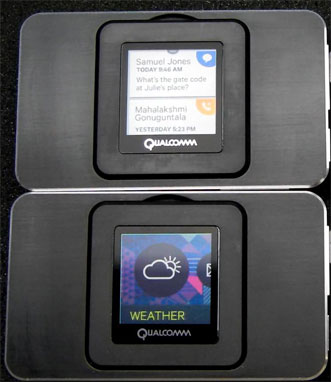SAN DIEGO, June 23, 2015 — A new type of display that uses tiny mirrors instead of light-emitting pixels could reduce screen glare and the amount of energy used by consumer electronics.
Based on microelectromechanical systems (MEMS), the display consists of a thin absorbing material that lets most of the light pass through to a second mirror layer. Interference between the incident and reflected light produces the desired output colors.
"We have developed an entirely new way of creating a color display," said John Hong, a researcher at Qualcomm MEMS Technologies Inc., which produced the Marisol display. "The incredibly efficient display is able to create a rich palette of colors using only ambient light for viewing, much like the way we would read and view printed material."

The Marisol displays render both images and video using only the ambient light in an average fluorescent-lamp-lit office environment as illumination. Courtesy of Optica.
Earlier attempts to create reflective color displays presented a number of vexing problems. The designs required using three separate pixels to produce the red, green and blue of a traditional display. Though adequate for certain applications, the fact that only one-third of the incoming light could be reflected back toward the viewer in a typical reflective RGB format limited the gamut of colors and brightness of the display.
The new display exploits interferometric absorption to create a bright, broad spectrum of colors.
As incident and reflected light interfere and produce standing waves inside the device, MEMS actuators move the absorbing layer to match a node in the standing waves corresponding to the desired colors. The spectral components not associated with that node are efficiently absorbed, allowing only the desired color to leak through the structure and back toward the viewer. Each pixel therefore behaves as a colored mirror, with the color being tunable across the entire visible spectrum.

Depending on how the display is used, power savings can exceed current backlit technologies tenfold, the researchers said. The greatest benefit is when a particular image is retained on the display, which then operates like a form of analog memory in a virtually power-free display mode.
It can even produce high-quality images in bright, outdoor environments.
"No more squinting at a hard-to-read display outdoors where we spend much of our time," Hong said. "We ultimately hope to create a paper-like viewing experience, which is probably the best display experience that one can expect, with only the light behind you shining on the page."
The design consists of a panel 1.5 in. across and containing approximately 149,000 pixels. The display rate is variable from 1 to 120 Hz. Both the resolution and area of the display can be scaled to match those of various mobile devices, the researchers said.
Fabrication can be achieved in one piece, with the MEMS, upper layer and lower layer created using the same deposition, lithography and etching processes that are used to create LCDs.
"Our goal is to improve the technology and design so it can be easily integrated into manufacturing processes at existing factories," Hong said.
The research was published in Optica (doi: 10.1364/optica.2.000589).
For more information, visit www.qualcomm.com.